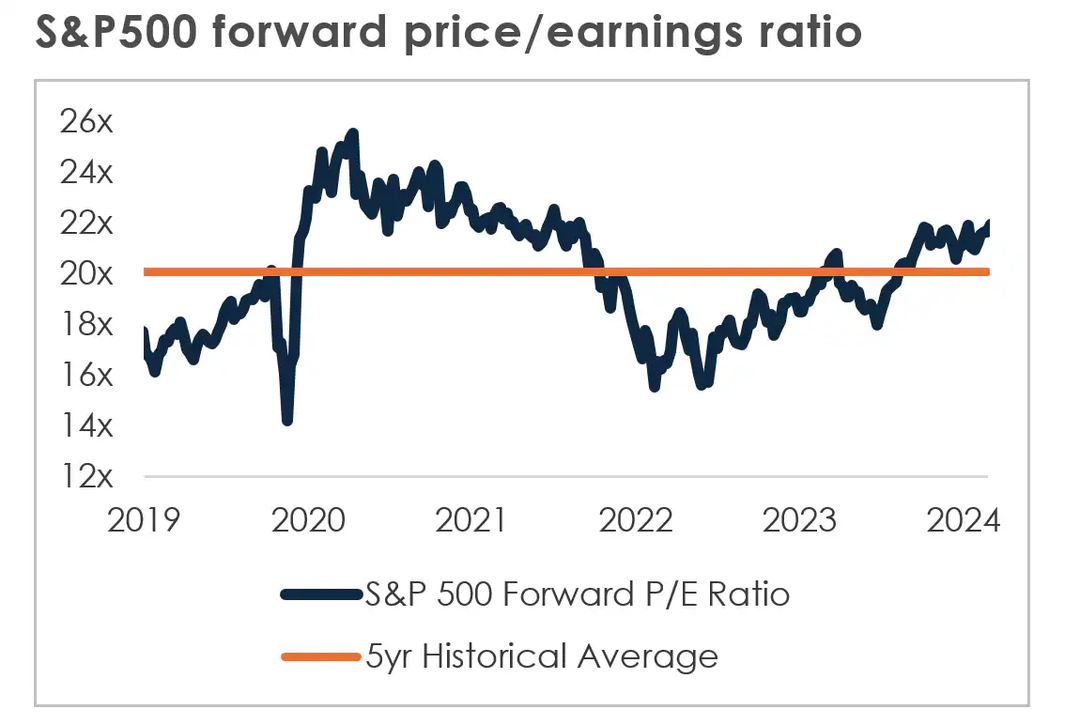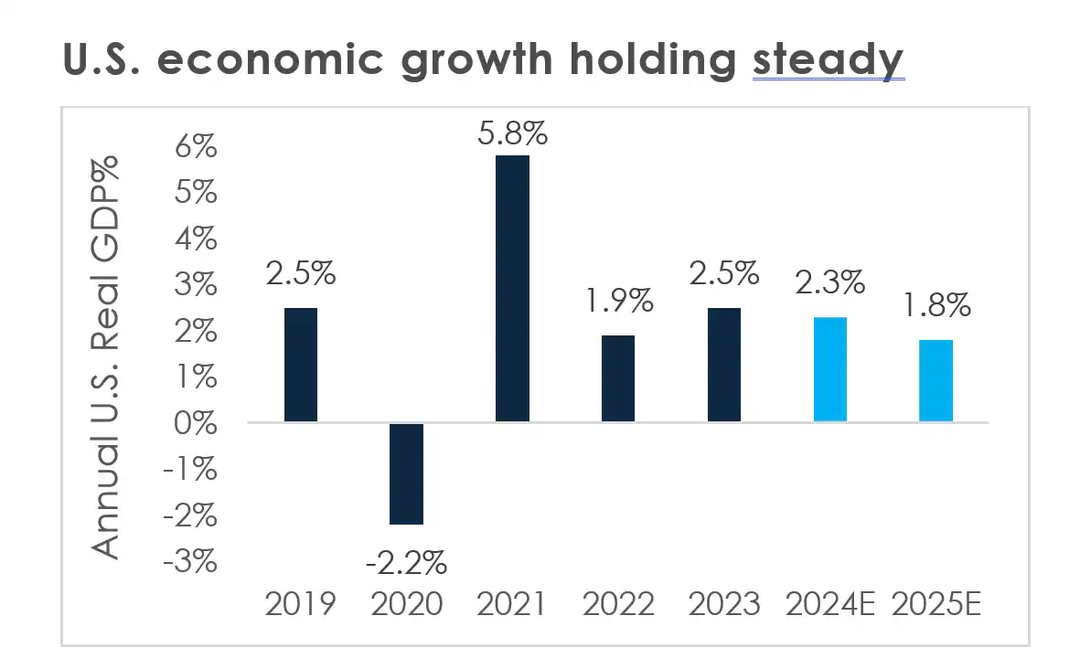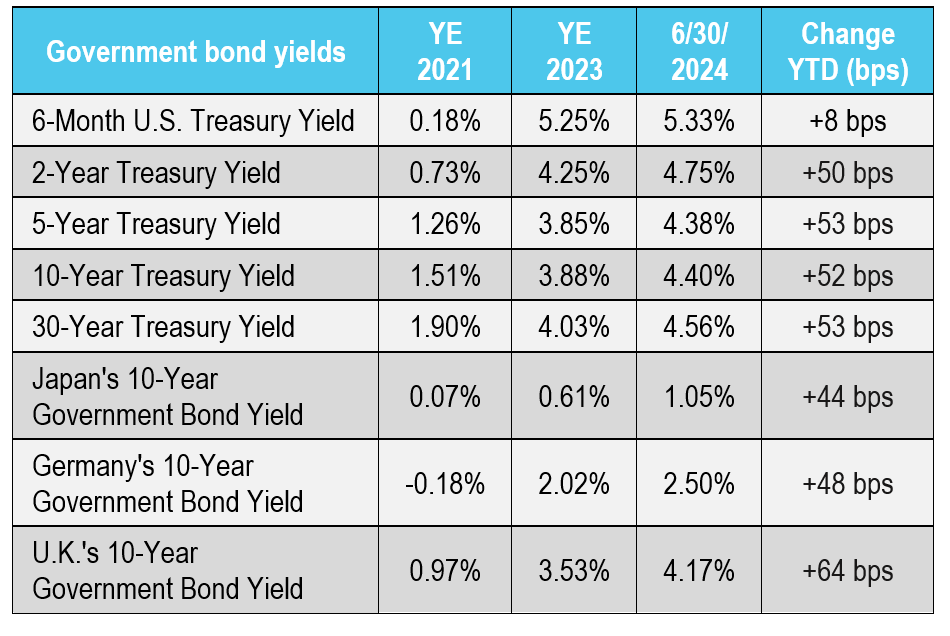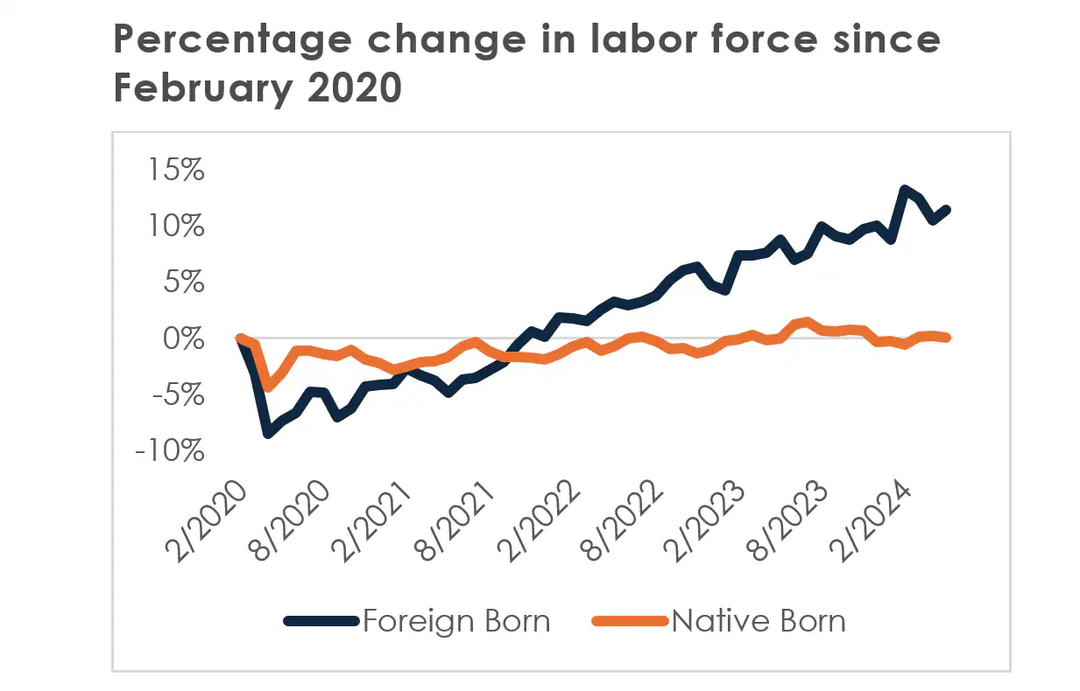By: Kelly Kowalski CFA, Bronwyn Tierney CFA and Kevin Schultz

The second quarter delivered positive returns for investors across almost all major asset classes. Global equities have continued to make new highs, led by the Artificial Intelligence (AI) revolution in the U.S. While consumer and business sentiment has sunk lower throughout the quarter, the narrative for stocks and bonds has been hard to describe as anything but optimistic.
The fundamental supports have all held in:
- The economy is growing.
- Corporate earnings are strong.
- The U.S. labor market is creating still-plentiful jobs.
- Household wealth continues to reach new records.
June marked the seventh winning month out of the past eight for the S&P 500, bringing year-to-date total returns to approximately 15 percent. There are now officially three U.S companies with equity market capitalizations over $3 trillion. Without question, it’s a bull market, but the probability of something going awry is rising. Specifically, signs are mounting for the Fed that restrictive monetary policy is influencing the economy, consumer spending is slowing, and concerns are rising over the political environment as the presidential election approaches.

Source: Bloomberg as of June 30, 2024.1
Equities and credit
Despite a strong first half of the year for equities, forward outlooks are mixed. Some investors believe the unprecedented growth of AI, ebbing inflation, and strong corporate earnings will drive upside, while others see eerie parallels to the 1999 tech bubble.
Taking the more pessimistic view first, like the 1999 tech bubble, the market is driven by technology stocks, is highly concentrated, and has a large gap between market cap weights and earnings. In particular, S&P 500 returns are skewed by the top 10 weights, which account for 77 percent of the year-to-date appreciation, mainly from tech giants such as Microsoft, Apple, Nvidia, Amazon, and Meta. Nvidia alone has contributed more than 30 percent to year-to-date appreciation. In fact, the top three mega-cap companies are now equivalent in size to 21 percent of the entire S&P 500 index market capitalization. The disparity between market caps and earnings of the top ten S&P constituents is also unprecedented, with these companies making up 35 percent of the S&P weighting while only contributing 23 percent in earnings. This raises questions about both sustainability and valuations.
On the other hand, the underlying rate environment, volatility, and broad market P/E ratios are much more favorable than those seen in prior bubble eras. The low-rate environment of 1999 spurred risk-taking and speculation due to cheaper capital. In contrast, today’s environment is more driven by optimism surrounding underlying fundamentals, economic growth, and the expectation for interest rate cuts. In fact, the consensus estimate for full-year 2024 S&P 500 earnings growth is 11.3 percent. Earnings grew just 1.0 percent in 2023. While current valuations may seem rich when focusing on the chunkiest constituents, the overall S&P 500 forward P/E ratio is around 21 times today, versus 25 times during the tech bubble.

Source: Bloomberg as of June 30, 2024.
Pivoting to credit markets, the year-to-date backdrop has been characterized by:
- An unusual mix of higher treasury yields.
- Higher than expected corporate debt issuance.
- Tighter corporate bond spreads.
Treasury yields have experienced upward moves across the yield curve of about 50 basis points since the start of the year as expectations for interest rates cuts have been dialed back.
The sustained tight levels of credit spreads are being driven by attractive all-in yields and strong underlying fundamentals resulting in high demand for bonds. Yields are slightly below 2023 peaks but are still at some of the highest levels seen in the past decade. Specifically, the investment grade corporate index is yielding around 5.5 percent while the high yield corporate index is around 8 percent. Also, investment grade corporate credit and high yield spreads have sustained levels near or below 100bps and 315bps, respectively, compared to their respective historical averages of 150bps and 525bps. This is evidently a signal of how expensive the asset class appears to investors on a historical basis, but also demonstrates the strength of the markets and ability for issuers to access this attractively priced debt capital.
Fed and the economy
The U.S. economy cooled more than expected in the first quarter of the year, with GDP growing at a 1.6 percent annualized rate (versus 3.4 percent in the fourth quarter) but remained healthy by historical standards. On a relative basis, the U.S. is far outpacing peers. Economists now expect full-year growth of 2.3 percent, more than tripling the expectation for the Eurozone’s 0.7 percent.

Source: Bloomberg as of June 30, 2024.
Market expectations have been on somewhat of a roller coaster ride starting the year with anticipation for six interest rate cuts, and now projecting just two twenty-five basis point cuts for the remainder of the year. According to Federal Reserve Chairman Jerome Powell, the U.S. is back on what he calls “a disinflationary path”. This claim is supported by the Core Personal Consumption Expenditure (PCE) Index, the Fed’s preferred inflation measure, which rose just 2.6 percent year-over-year in May. This was the lowest month since March 2021. The Fed is keeping a careful eye on warning signs that the real economy is weakening. This includes the fact that the unemployment rate, while still low by historical standards, has risen steadily from 3.4 percent in April of 2023 to 4.1 percent as of June. As we have commented on in the past, consumers have also run their pandemic-era excess savings dry. As such, it should come as no surprise that this has started to show up in earnings calls, with consumer behemoths like Starbucks citing slower foot traffic, and McDonalds seeing sluggish sales in the first quarter.
Europe, in an objectively weaker economic position than the U.S., saw the European Central Bank take the first interest rate cut action of the major central banks at their June meeting, opting for a 25-basis point reduction. In the U.S., the consensus call is for the first reduction to take place in September.
Government debt / election
The June debate between President Joe Biden and former President Donald Trump was the first of the 2024 election cycle and the earliest presidential debate in U.S. history. Inflation, immigration, and the economy are top of mind issues for the upcoming election.
Government spending is a central tenet in all these issues. The national debt reached a record high of $34.9 trillion in June, equivalent to 122 percent of the gross domestic product (GDP) of the country. There’s been an intense amount of focus on how the elections could further move the fiscal needle. Arguing about which party is to blame for the debt avoids an important truth: both Democrats and Republicans are at fault for our increasingly overextended fiscal position; about two-thirds of the total national debt has been incurred since 2001.
The post-pandemic government spending that we have seen is a double-edged sword. On the positive, we have effectively spent our way out of incurring a recession. Annual deficit spending at a level equal to 7 percent of GDP with the economy running at full employment is a statistical outlier and is highly unusual. However, concerns associated with how to pay for this year’s nearly $2 trillion deficit — which briefly captured market participants’ attention last fall — will likely come back. Longer-term treasuries are likely to be most vulnerable as uncertainty about our debt sustainability mounts.

Source: Bloomberg as of June 30, 2024
Labor market and immigration
The U.S. economy has not only avoided a downturn, but also greatly surpassed the growth of other countries and even predictions for its own expansion. This is largely due to the strong performance of the labor market, as the data shows. In the first half of the year, the U.S. added an average of 264,000 jobs per month, or about 63,000 more jobs per month than expected. This stunning growth raises questions when looking under the surface. Indicators derived from the official government reports, namely payrolls and wages reports, have been stronger than expected; however, indicators from household surveys, like the unemployment and labor force participation rates have been worse than expected.
The reason for this? Many economists now believe that the impacts of immigration have been seriously underestimated.
Being an election year, immigration has sharply come into focus with 36 percent of voters citing it as a top concern in the upcoming presidential election. Between 2014 and 2019, immigration remained relatively stable, with flows averaging approximately one million people per year. Last year however, the U.S. experienced a record high net gain of 470,000 foreign-born in December 2023, and four million throughout the full year. Per Barclays, foreign-born people represent around 20 percent of total employment in the U.S. but accounted for about 75 percent of the increase in private sector employment over the past year. Despite the political controversy, this post-pandemic surge in immigration has had positive effects on the U.S. economy, such as easing labor shortages and the associated inflationary pressures. It is key to remember that consumer spending accounts for more than two-thirds of GDP, and when more people have jobs, they can spend more and boost the economy.

Source: Apollo as of June 30, 2024
Looking ahead
As we enter the second half of the year, it appears as if fundamental drivers of the economy have moved closer to the Fed’s 2 percent inflation target. Price and wage growth have slowed, while employment has remained at historically strong levels. When the economy is growing, and earnings are growing, that typically creates a positive backdrop for markets. However, prudent investors may consider the following: the 25-year average intra-year drawdown of the S&P 500 has been 16 percent, and we have seen a mere 6 percent over the first half of the year.
Looking to the imminent horizon, the second quarter earnings season and outlook will be a key driver of market sentiment, especially for the big banks and the tech sector. We remain more cautious now given market concentration, elevated valuations, and rising political and trade risks. As always, we encourage you to speak with a MassMutual financial professional to help you plan your future.
1 NASDAQ = NASDAQ Index, Value = iShares Core S&P U.S. Value Index, S&P 500 = S&P 500 Index, REITS = Vanguard Real Estate ETF, Small Cap = Vanguard Small-Cap ETF, Developed Markets = Vanguard FTSE Developed Markets ETF, Emerging Markets = Vanguard FTSE Emerging Markets ETF, Gold = SPDR Gold Shares ETF, Commodities = iShares S&P GSCI Commodity-Indexed Trust ETF, Aggregate Bonds = iShares Core U.S. Aggregate Bond ETF, TIPS = iShares TIPS ETF.
The information provided is not written or intended as specific tax or legal advice. MassMutual, its employees and representatives are not authorized to give tax or legal advice. You are encouraged to seek advice from your own tax or legal counsel. Opinions expressed by those interviewed are their own and do not necessarily represent the views of Massachusetts Mutual Life Insurance Company.
Market Indices have been provided for informational purposes only; they are unmanaged and reflect no fees or expenses. Individuals cannot invest directly in an index.
Description
The NASDAQ Composite Index is a broad-based capitalization-weighted index of stocks in all three NASDAQ tiers: Global Select, Global Market and Capital Market.
The iShares Core S&P Value ETF is an exchange-traded fund incorporated in the USA. The Fund seeks investment results that correspond to the performance of the S&P 900 Value Index. The Index measures the performance of the value sector of the broad U.S. equity market.
The S&P 500 Index is widely regarded as the best single gauge of large-cap U.S. equities and serves as the foundation for a wide range of investment products. The index includes 500 leading companies and captures approximately 80% coverage of available market capitalization.
The Vanguard Real Estate ETF is an exchange-traded fund incorporated in the USA. The Fund seeks to track the performance of the MSCI
U.S. IMI 25/50 Real Estate Index. The Fund invests in the stocks that make up the Index, holding each stock in the same proportion as its weighting in the Index; the remaining assets are allocated to cash investments.
The Vanguard Small-Cap ETF is an exchange-traded fund incorporated in the USA. The ETF tracks the performance of the CRSP U.S. Small
Cap Index. The ETF holds over 1400 mid and small cap stocks. Its investments are focused in the United States and are diversified across industries. The ETF follows a full replication strategy and weights the holdings using a market capitalization methodology.
The Vanguard FTSE Developed Markets ETF is an exchange-traded fund incorporated in the USA. The ETF tracks the performance of the
FTSE Developed All Cap ex US Index. The ETF holds large-, mid-, small-cap companies located in Canada and the major markets of Europe and Pacific Region.
The Vanguard FTSE Emerging Markets ETF is an exchange-traded fund incorporated in the USA. The ETF tracks the performance of the FTSE Emerging Markets Index. The ETF holds large and mid-cap stocks in emerging markets around the world. Brazil, Russia, India, Taiwan, China, and South Africa are among the markets included. The ETF weights these holdings based on market capitalization.
The SPDR Gold Shares is an investment fund incorporated in the USA. The investment objective of the Trust is for the Shares to reflect the performance of the price of gold bullion, less the Trust's expenses. The Trust holds gold and is expected from time to time to issue Baskets in exchange for deposits of gold and to distribute gold in connection with redemptions of Baskets.
The iShares S&P GSCI Commodity-Indexed Trust ETF is an exchange-traded fund incorporated in the USA. The Fund's objective is that its performance will correspond generally to the performance of the S&P GSCI Total Return Index. The Fund invests in a diversified group of commodities.
The iShares Core U.S. Aggregate Bond ETF is an exchange-traded fund incorporated in the USA. The ETF tracks the Bloomberg US Aggregate Bond Index by investing in securities within the total U.S. investment-grade bond market. This includes treasuries, government-related and corporate securities, MBS, ABS and CMBS.
The iShares TIPS ETF is an exchange-traded fund incorporated in the USA. The ETF will track the Bloomberg US Treasury Inflation Notes Index. The Index measures the performance of inflation protected public obligation of the US Treasury, also known as "TIPS".
Past performance is no guarantee of future performance or market conditions. Investing involves risk including the possible loss of principal. Investment return and principal value will fluctuate so that when sold may be worth more or less than the original cost.
Use of political figures or statements is solely for reference and relevance to financial markets and is not meant to be an endorsement or a reflection of the company’s opinion or position.
This material is intended for informational purposes only and does not constitute a recommendation to engage in or refrain from a particular course of action. The information within has not been tailored for any individual and is not intended as tax, legal or investment advice.
The views and opinions expressed are those of the author as of the date of the writing and are subject to change without notice. Although the information has been gathered from sources believed to be reliable, it is not guaranteed. Please note that individual situations can vary, therefore, the information should be relied upon when coordinated with individual professional advice. Clients must rely upon his or her own financial professional before making decisions with respect to these matters.
This communication may include forward-looking statements or projections that are subject to certain risks and uncertainties. Actual results, performance, or achievements may differ materially from those expressed or implied.
Investments discussed may have been held in client accounts as of June 30, 2023. These investments may or may not be currently held in client accounts.
MM202707-309681


